Many of us will imagine apricot scrubs and scratchy flannels when we think about exfoliation. For so many years, exfoliation was a mechanical process, where we literally scrubbed off our skin. The modern method of exfoliation is that which involves using chemicals - or acids. Waaaah! Acids? Don''t fret. They're good acids, also known as AHAs.
Exfoliating Your Skin. What Are AHAs?
If your skincare routine doesn’t already include AHAs, they could be the secret to upping your skin exfoliation game. Splashing an AHA exfoliating liquid on your face can really help you get your glow on by keeping skin clear, bright and radiant. But, hang on. What are AHAs? Let’s find out what they are, how they work and why you need liquid exfoliation in your skincare life.
AHAs: what they are
Okay, first things first. What are AHAs, exactly? When you break this nifty little initialism down, it stands for ‘alpha hydroxy acids’. See why the initials are used more often?
Yes, AHAs are acids - but they're the good kind. They work as chemical exfoliants and can help keep the skin clear, even-toned and even-textured. Simply swipe your AHA over your face and let it do all the work - these leave-on exfoliants are pretty great for those of us who want glowing skin without the hassle!
How do AHAs work?
It’s time for some skincare science. Every one of us - unless you’re a veteran chemical peeler - has a layer of dead skin sitting on top of our faces. What a nice thought!
This wall of dead skin cells (known officially as the stratum corneum) is held together with a glue-like substance and can make the skin look dull and tired. And this is where AHAs come in: they loosen the glue between dead skin cells, making it easier for them to shed. The result? Brighter, radiant skin (and loads more benefits I’ll tell you about in a sec!).
How do AHAs benefit the skin?
AHAs are water-soluble (in non-scientific terms: they dissolve in water) and work best at the surface-level of the skin. So, an AHA liquid exfoliant is great for superficial skin concerns (nothing too deep) like fine lines and wrinkles, light scarring, hyperpigmentation and uneven skin tone and texture. And this type of chemical exfoliant is most effective for dry, mature or sun-damaged skin.
But, the benefits of AHAs don’t stop here. They also have humectant properties, drawing water to the skin and helping it stay hydrated and moisturised. They can also lend a helping hand if your skin is lacking firmness and plumpness: AHAs get rid of old collagen fibres, allowing new ones to take their place - fabulous for ageing skin that needs a youth-boost!
The anti-ageing benefits of AHAs are so good, in fact, that one study reported 9 out of 10 women noticed an improvement in their crow’s feet and skin roughness after adopting a skincare regime containing AHAs for three weeks. Nine out of ten!
AHAs can also help keep breakouts away by removing dead skin cells (one of the main culprits of clogged pores) from the surface of the skin. But, if you’re looking to beat congestion, blackheads and whiteheads, a BHA liquid exfoliant (another liquid exfoliator) might be your best bet.
It’s important to know that AHAs make the skin photosensitive, meaning it’s more susceptible to UV damage. So, it’s really important to wear sunscreen when using them!
AHAs are the secret to super skin!
What are the different types of AHAs?
Now we know what AHAs are, let’s look at them individually:
Glycolic acid
Naturally derived from sugar cane, glycolic acid is the most celebrated AHA. This is mostly because it has the smallest molecules of all the AHAs, meaning it can penetrate the skin best. It’s a very effective exfoliator (arguably the best of the AHAs) and tackles most skin grievances - hyperpigmentation, acne, sun damage and uneven texture, to name a few.
Lactic acid
Sourced from milk, this acid has a larger molecular size than glycolic acid, which means it doesn’t penetrate the skin as easily. So, it’s a gentler alternative than glycolic acid that’s better for sensitive skin. But, don’t be fooled - it’s still a great exfoliator. It’s good for treating hyperpigmentation and it’s hailed for its hydrating effects.
Tartaric acid
Tartaric acid, a grape derivative, has a big molecular size - so it’s often used as a complementary acid, rather than on its own. It helps to maintain and regulate the pH of other acids (this is important since skin irritation can occur when an acid’s pH is out of whack!) and, when combined with other AHAs, it can increase exfoliation.
Citric acid
This is a citrus fruit derivative (shocker!). It’s an antioxidant (so it can protect the skin from free radicals) and is also great for brightening the skin. It’s also used to help maintain the right pH balance of products. One thing, though: it can be irritating on the skin.
Malic acid
Malic acid is predominantly derived from apples and has antioxidant properties - always a good thing! It’s often used with other AHAs (like glycolic and lactic acid) since it’s not super powerful on its own.
Mandelic acid
Derived from bitter almonds, mandelic acid molecules are the largest of all the AHAs - so it takes the longest to penetrate the skin. This means it’s gentler and less irritating on the skin than some of the other AHAs - perfect for sensitive skin. It’s also antibacterial, so it’s a good choice for acne-prone skin (oily skin too!).
So, there we have it - all you need to know about AHAs! Trying an exfoliating acid has the potential to help clear up a whole range of skin issues, leaving you fresh-faced and glowing. Dry skin? Dullness? Signs of ageing? Sun damage? Get yourself an AHA.
If you're looking for bespoke advice on AHAs or any other skincare ingredients, book a consultation with an aesthetics pro who you can find right here on Glowday!

